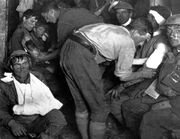Assessment |
Biopsychology |
Comparative |
Cognitive |
Developmental |
Language |
Individual differences |
Personality |
Philosophy |
Social |
Methods |
Statistics |
Clinical |
Educational |
Industrial |
Professional items |
World psychology |
Clinical: Approaches · Group therapy · Techniques · Types of problem · Areas of specialism · Taxonomies · Therapeutic issues · Modes of delivery · Model translation project · Personal experiences ·
The thousand-yard stare or two-thousand-yard stare is the unfocused gaze of a battle-weary soldier. The stare is a characteristic combat stress reaction which may be a precursor to, or symptom of, post-traumatic stress disorder.

Painting of Marines Call It That 2,000 Yard Stare

Image from World War I taken in an Australian Advanced Dressing Station near Ypres in 1917. The wounded soldier in the lower left of the photo has a dazed, thousand yard stare - a frequent symptom of "shell-shock".
The phrase was popularized when, in 1944, Life magazine published the painting Marines Call It That 2,000 Yard Stare by its World War II artist and correspondent Tom Lea. The painting was a portrait of a young marine at the Battle of Peleliu in 1944, and is now held by U.S. Army Center of Military History, Fort Lesley J. McNair, Washington, D.C. About the real-life Marine who was his subject, Lea wrote:
He left the States 31 months ago. He was wounded in his first campaign. He has had tropical diseases. He half-sleeps at night and gouges Japs out of holes all day. Two-thirds of his company has been killed or wounded. He will return to attack this morning. How much can a human being endure?[1]
Frank Johnston, a Vietnam War photographer used the term in a 2001 Smithsonian magazine interview. Johnston says, "I looked up and saw a Marine with what they call the thousand-yard stare, and I lifted my Leica and snapped his picture. The soldier’s gaze never left my lens."[2]
When recounting his arrival in Vietnam in 1965, then-Corporal Joe Houle said he saw no emotion in the eyes of his new squad: "The look in their eyes was like the life was sucked out of them." Later learning that the term for their condition was the 1,000-yard stare, Houle acquiesced, "After I lost my first friend, I felt it was best to be detached."[3]
References[]
- ↑ "War through the eyes of artists". (Transcript of televised broadcast) America's Defense Monitor, Program Number 438. Center for Defense Information. URL accessed on 2006-10-27.
- ↑ Pleasants, Angela M. "The Thousand-Yard Stare". Smithsonian (magazine).
- ↑ includeonly>Stone, Sgt. Arthur L.. "Retired Sgt. Maj. Joe Houle recounts Vietnam tour", Marine Corps News, 2002-05-02.